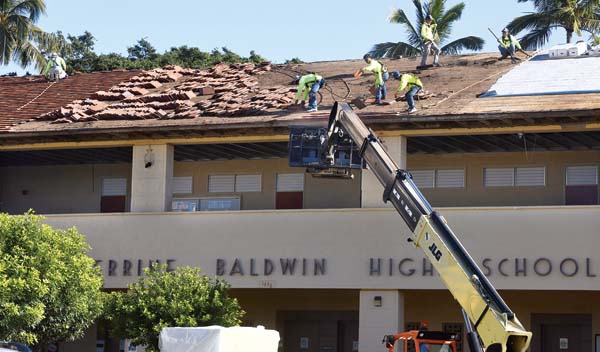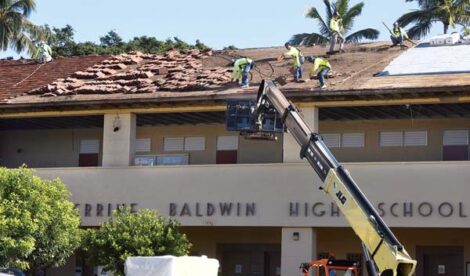Tourism, construction still Hawaii’s recession buffers
Economist: It’s ‘hard to be pessimistic’ amid positive signs in the local economy

Workers from MEI Corporation remove roof tiles from Baldwin High School’s Administration Building Tuesday morning as part of a reroofing project. Construction activity is one of the factors that could help buoy Hawaii’s economy in the event of a U.S. recession, local economists say. The Maui News / MATTHEW THAYER photo
Despite heightened risks, Hawaii economists believe the state is still likely to avoid an outright recession due to tourism and construction activity softening the hit.
Though not a whole lot has changed since March, recent developments in the nation’s economy bring both “promise and peril” for Hawaii, according to the University of Hawaii Economic Research Organization’s second quarter forecast for 2023.
“Despite greater downside risks, we believe that Hawaii will avoid a recession,” UHERO Research Economist and Associate Professor of Economics Peter Fuleky said last week during a forecast report. “And overall, we are optimistic about Hawaii’s longer-term prospects for three reasons: we remain a top destination for visitors from around the world, we have a population diversity and cohesion that is the envy of other places, and we have public, private, and nonprofit leaders who are serious about finding solutions to emerging challenges.”
Given these advantages, Fuleky said, “it’s hard to be pessimistic about the future.”
Still, the Federal Reserve appears likely to maintain its high interest rate policy for some time, and tighter lending conditions associated with recent bank failures will also weigh on U.S. growth.
An expected recession beginning late this year will hold the U.S. gross domestic product growth to 1.5 percent this year and 0.3 percent in 2024, the report said.
A national recession will weigh on Hawaii, but “local sources of strength should keep our heads above water,” UHERO said.
Despite the delayed recovery of the Japanese market, tourism rates in Hawaii are promising and will continue to sustain the economy, with activity only slightly below 2019 levels. With that comes strong visitor spending across all islands, even without the complete return of international tourism. Maui, which is more reliant on tourists from the U.S. Mainland, has seen visitor arrivals nearly at pre-pandemic levels and higher spending than in 2019.
Visitor demand continues to benefit hotels, specifically, causing room rates to soar on the Neighbor Islands. Statewide, real revenue per available room is now 6 percent higher than in 2019.
Both the number of visitor days and visitor spending will fall slightly next year, before returning to moderate growth, the report said.
“The state is partially insulated from a U.S. recession because international visitors are still recovering, but these mostly visit Honolulu and the Big Island,” UHERO Assistant Professor Steven Bond-Smith said Tuesday. “So the impact of a U.S. recession could be greater on Maui than elsewhere in Hawaii because it has a greater reliance on U.S. visitors. U.S. visitors to Hawaii already reached a record level in 2021, higher than the pre-pandemic level in 2019.”
Construction activity will remain high as inflation is predicted to recede rapidly in Hawaii compared to the Mainland, setting the stage for real income gains, according to UHERO.
Income and hourly earnings in the state nearly recovered to pre-pandemic levels last year and will grow at a 2.5 percent average annual pace over the next three years. In Maui County, average income is predicted to rise slightly by 2.2 percent and 1.8 percent over the next two years.
At the same time, housing cost inflation and inflation in other services, such as travel, groceries, doctors’ visits, entertainment and energy, remain the same this year.
“There has been essentially no retreat yet in this price category,” the report said. “Because these service categories are labor-intensive, a concern is that strong wage growth will continue to propel price gains in this area and therefore overall inflation. Luckily, underlying wage pressures are gradually easing.”
The Hawaii labor market is considered healthy with about a 3.5 percent unemployment rate due to labor force recovery and lessening labor demands, which have “largely eliminated the overall worker shortage.” Businesses may still experience hiring challenges, however.
In Maui County, the unemployment rate is at 3.9 percent and is expected to rise to 4.3 percent next year, and then drop back down to 3.9 percent in 2025 — this trend is caused by weakening U.S. tourism activity, tight credit and high interest rates.
Labor force recovery differs by county in Hawaii. Changes in the workforce statewide may be due in part to “heightened cost of living concerns” in the face of ongoing pandemic-era economic challenges, the report said.
Fuleky said that high mortgage rates are an additional barrier for new homeowners. Surging home prices and mortgage interest rates have made affording a single-family home require twice the income it did a decade ago.
According to the Realtors Association of Maui, the median sales price for a single-family home in Maui County in April was $1.1 million.
“Roughly 80 percent of all households earn less than what is necessary to afford a median-priced home,” Fuleky added.
And, half of local households can’t afford a condominium either, he said.
The culprit is a lack of new supply. Compared to the rest of the nation, Hawaii is not building enough new single-family units, ranking 49th in the U.S. in terms of housing permitted compared to nearly two decades ago in 2005, according to the report. This lack of new housing is partly responsible for high prices of materials for contractors, permitting delays and the availability of labor.
Still, major public sector projects will support a high level of construction activity. The construction job count in Hawaii will top 41,000 by 2026, he said. In Maui County, construction and mining jobs are up 7.3 percent.
* Dakota Grossman can be reached at dgrossman@mauinews.com.
- Workers from MEI Corporation remove roof tiles from Baldwin High School’s Administration Building Tuesday morning as part of a reroofing project. Construction activity is one of the factors that could help buoy Hawaii’s economy in the event of a U.S. recession, local economists say. The Maui News / MATTHEW THAYER photo


